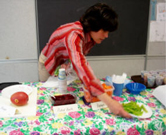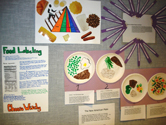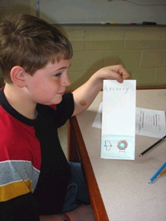Reading, Writing, and Reducing Obesity
October 2006

Tracy Dawson-Greene sets out healthy snacks for her 7th grade class at John F. Kennedy Middle School in Florence, Massachusetts, after a Planet Health lesson on nutrition.
"Carbohydrates. Who has any idea what that's all about?"
Heather Bacon stands in front of her 6th-grade class in Ludlow, Massachusetts, and takes answers from a dozen students with raised hands.
They are working on a "word splash," connecting concepts about nutrition as they learn reading comprehension skills. The lesson is part of a unique curriculum designed at the Harvard Prevention Research Center, one of 33 centers funded by the Centers for Disease Control and Prevention that work to prevent chronic disease.
Called Planet Health, the lessons combine important messages on nutrition and physical activity with four academic subjects: social studies, math, science, and language arts.
Two 11-year-old girls discuss how to relate concepts on their word splashes.
"'Energy source' can go with 'sugar,'" says one girl. "Really?" asks another sitting opposite her. "Yeah, it makes you bounce off the walls," the first explains. "Oh, yeah," her friend replies with a giggle. They go on to connect 'balanced diet' and 'protein' and discuss their answers with their teacher and classmates.
Even though obesity is affecting many of America's children, health classes, nurses, and physical education (P.E.) still disappear from public schools because of tight budgets. These lessons are more important than ever, teachers say.
"The time kids spend in health and P.E. has been cut down," says Tracy Dawson-Greene, a 7th grade social studies teacher at John F. Kennedy (JFK) Middle School in Florence, Massachusetts. "I asked the kids about food groups. It was sketchy. One of the kids asked me if fish is in the dairy group. They're just not getting it in the other classes."
The Planet Health curriculum meets Massachusetts academic standards and includes lessons designed to fit into a teacher's busy schedule. Kids get 24 lessons a year, six from each teacher in the four main subjects, plus special activities in their P.E. classes.
Planet Health also challenges students to turn off their televisions. Harvard researchers have shown that television viewing is directly related to obesity. The curriculum encourages kids to have two hours or less of "screen time" a day, including television, video games, and computer time.
"For each hour of television viewing, kids consume an extra 167 calories a day," says Steven Gortmaker, Ph.D., director of the center, who has studied childhood obesity since the 1980s. Planet Health focuses on middle school children because extra weight put on in adolescence can stick around until adulthood, Gortmaker said.
Dr. Gortmaker looked for curriculum writers for Planet Health who would incorporate the knowledge of families, teachers, and principals. "We wanted to make sure we were connected to the way the kids were thinking about the world," he said.

Middle school students taking Planet Health lessons created this wall display to explain food labeling and portion size. Enlarge picture.
One Planet Health lesson shows children how much of their day they spend watching television by using a pie chart, and then lets students choose other activities to fill the pie. Gortmaker said it's important that the students make their own decisions about how to live healthfully.
"If kids choose stuff, they are more empowered. We're not focused so much on the parents. They're telling the students what to do. We want the kids to make their own choices."
In a 2-year study at 10 middle schools, Planet Health not only reduced the amount of time boys and girls watched television, but also lowered the prevalence of obesity among girls. Another study shows the program will save money for the children later in life; for every dollar spent on the program in middle school, $1.20 in medical costs and lost wages would be saved when the children reach middle age.
Blue Cross Blue Shield of Massachusetts picked up the program in 2004 as part of an overall school wellness program, and it is now used in more than 120 schools across the state. The YMCA has also started offering a version of Planet Health during after school programs in Massachusetts. Since 2001, when the curriculum was put into book form, more than 4,000 copies have sold. Researchers are working on a new edition that will add and update information about sugar-sweetened beverages, the different types of fats, and whole grains.
Jill Carter, co-author of the curriculum and a former science teacher, said she especially enjoyed coming up with lessons for science classes.
"Sugar-sweetened beverages can be a chemistry lesson," she said. So can talking about how the body uses calcium and iron—when it is combined with a look at the elements on the periodic table, she explained.
And don't forget the physics in physical activity, Ms. Carter said. "The long jump lesson can relate to potential energy and kinetic energy."

Eric Bowler, a 6th-grader at John F. Kennedy Middle School in Florence, Massachusetts, displays a brochure he made detailing his favorite physical activity—archery. Eric said he also enjoys climbing trees.
Teachers are encouraged to adapt the lessons as needed. Amy Burlingame, a 6th-grade teacher at JFK Middle School, recently did that for children with a learning disability. For a lesson on physical activity, instead of having the students write an essay, she had them create brochures about their favorite physical activities and asked them to use whole sentences. The students, who named bicycling, skating, and swimming as favorite activities, were required to use two sources to research the brochure.
"All the skills that they are learning and practicing are skills they need anyway," Ms. Burlingame said. "And the content, it's all the stuff that I believe in."
Researchers and administrators say the biggest success of the program is the lifestyle changes it inspires—not just in classrooms, but in whole communities. Schools that use Planet Health have begun to hold fitness days for families. Teachers have started yoga classes for themselves. At a school in Warren, Massachusetts, the food service coordinator stopped serving fried food. Schools have used mini-grants that come with the program funds to pay for exercise equipment.
"It can snowball into these really huge collaborative efforts," said Christine Horan, a state coordinator for the program.
In Ms. Dawson-Greene's class, the Planet Health lesson of the day is about healthy food in foreign countries.
First, the students talk about the fruits and vegetables that they eat at home and the benefits of eating them. Ms. Dawson-Greene hints at a snack if the students are productive, but she won't tell them what it is. "You're not allowed to decide how productive you're going to be based on what the snack is," she tells the groaning 12-year-olds.
The students get charts with five places on them: Cambodia, Haiti, Brazil, Puerto Rico, and the United States. They find them on a map. The charts list some foods eaten in the different places and how they are prepared. The students then compare the types of foods and talk about what they have and have not eaten.
Finally, they get to try mango, papaya, green and red peppers, red cabbage, and pomegranate-cranberry juice. The mango is a big hit.
This was Ms. Dawson-Greene's second Planet Health lesson since being trained in the curriculum. In her first, 8th-grade students compared the level of physical activity in the United States before the Industrial Revolution with the present. She said the Planet Health curriculum inspires her, and she is planning a themed lunch to go along with an upcoming lesson on the Middle East.
"Today's nutrition lesson was a success," Ms. Dawson-Greene said. "They're late to lunch because they're chowing down on fruits and vegetables," she said.
One girl seemed to agree, as she left the classroom with a handful of green pepper slices.
"We have to do this again!" she said.
For information on how to obtain a copy of the curriculum, please visit the Harvard Prevention Research Center on Nutrition and Physical Activity* Web site.
* Links to non-Federal organizations are provided solely as a service to our users. This link does not constitute an endorsement of this organization by CDC or the Federal Government, and none should be inferred. The CDC is not responsible for the content of the individual organization Web pages found at this link.
![]() One or more documents on this Web page is available in Portable Document Format
(PDF). You will need Acrobat
Reader (a free application) to view and print these documents.
One or more documents on this Web page is available in Portable Document Format
(PDF). You will need Acrobat
Reader (a free application) to view and print these documents.
- Page last reviewed: April 1, 2008
- Page last updated: April 1, 2008
- Content source: Division of Adult and Community Health, National Center for Chronic Disease Prevention and Health Promotion
Get email updates
To receive email updates about this site, enter your email address:
Contact Us:
- Prevention Research Centers
4770 Buford Hwy, NE
MS K-45
Atlanta, GA 30341-3717 - cdcinfo@cdc.gov

